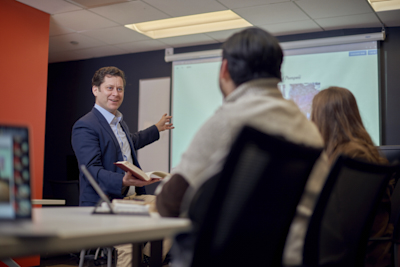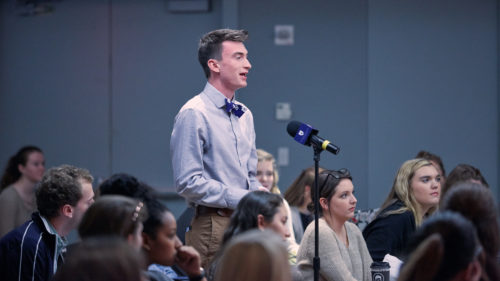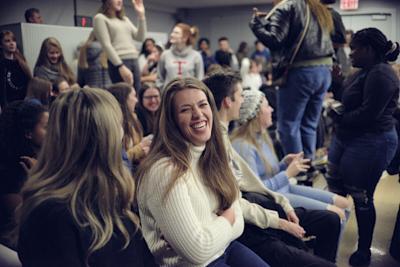August 2016 History Spotlight: King’s Literary Society
As students return to campus later this month, or move in for the first time, they will find opportunities to pursue their extracurricular interests through a wide variety of student organizations. One of the earliest student-led organizations at The King’s College was its literary society, founded in the College’s first academic year.

As students return to campus later this month, or move in for the first time, they will find opportunities to pursue their extracurricular interests through a wide variety of student organizations. One of the earliest student-led organizations at The King’s College was its literary society, founded in the College’s first academic year. The society allowed students “to develop their talents as well as their poise before others[1],” and flourished enough that it divided into two societies within two years—the Marconian Literary Society, for men, and the Patrician Literary Society, for women.
According to Christian higher education historian William Ringenberg, literary societies were “by far the most influential activity in American student life before the Civil War.”[2] Generally, these societies’ activities were based around oratory and debate, which made them a natural place for students to engage with issues current to their time. He elaborates:
“Nearly every college maintained at least two societies that competed intensely against each other in a variety of activities. Each sought to recruit the most capable members of the freshman class, each sought to have a larger and better library collection than the other, each sought to outfit its society hall more lavishly than did the other, and each sought to win the intersociety contests in oration, debate, and written composition.”
In fact, Ringenberg notes, the best comparison to the literary societies’ zeal in attempting to enroll the best freshmen is the effort of today’s athletic coaches to recruit top athletes for collegiate teams. Colleges valued the literary societies as supplements to their classics-centered curricula and, during their commencement-week oratorical performances, as public relations showpieces. In those days, literary societies often maintained better and more accessible libraries for their members’ use than did the educational institutions themselves, and also observed disciplinary codes that were just as strict as and more effective than the institutional ones. Ringenberg observes, “It is difficult to exaggerate the extent to which the literary societies exerted a positive influence upon student life.”
By the time The King’s College was founded, literary societies were on the wane throughout America. Curricula had diversified so that less emphasis was placed upon oratorical vocations such as ministry and law, and other extracurricular activities were competing for students’ time and attention—especially intercollegiate athletics, but also fraternities and musical groups.
It is clear that the Marconian and Patrician literary societies at King’s were not as consuming as the literary societies of the nineteenth century. There is no indication, for instance, that they had, or aspired to have, their own libraries or society halls. King’s students were deeply invested in sports, particularly basketball; they also had musical groups, a missionary society, a newspaper, and a student government. For as small as the College was in its first few years, this seems like a considerable number of extracurricular activities. However, the literary societies did attract impressive participation and produced a number of original pieces, including “Goldsmith and Hector’s Great Board of Directors” at Christmas in 1941—a rhyming fantasy in which the board of a retail store debates whether the meaning of Christmas is profits or worship.[3] This seems typical of the literary societies’ activities—they were humorous and creative, but the competitions were strictly friendly, and devotional messages were included in regular meetings and performances. The reason King’s existed was to fuel Christian service, and that purpose prevented subsidiary activities from taking on overblown importance.
The societies merged to become the Patrician Marconian Society during the 1943-1944 academic year, and also allowed faculty members to join, because the men’s society was depleted by the number of students who had left to answer the call of World War II. Indeed, some students joked at that time that the entire College should change its name to The Queen’s College to reflect the new student demographics.
From starting out at a fledgling institution, to moving campuses and losing students by transfer, to losing participation because of the war, to being active at a time when literary societies in general were in decline, the literary societies at King’s did themselves credit. Their closest analog at the present-day College is the King’s Debate Society, which has also done itself credit and deserves its own treatment another time—but it’s safe to say the early literary societies served uniquely to deepen fellowship and highlight talent in the college’s life at that time.
What are your favorite memories of extracurricular activities at King’s?
[1] The Crown, 1939
[2] All quotations from Ringenberg, William: The Christian College: A History of Protestant Higher Education in America, pp. 73-76. 2nd ed. Grand Rapids: Baker Academic, 1996.
[3] The Crown, 1941




